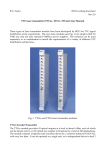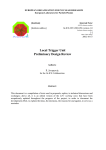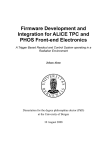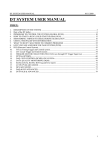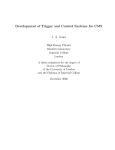Download C TTC machine interface (TTCmi) User Manual
Transcript
C TTC machine interface (TTCmi) User Manual Rev 1.3 B.G. Taylor Fig. 1 TTCmi minicrate Introduction The RD12 TTCmi provides a standard interface between the LHC machine timing which is broadcast from the Prevessin Control Room (PCR) and the TTC distribution systems of the individual LHC experiments. The TTCmi consists of a minicrate (see Fig. 1) containing a number of modules which are configured to suit the requirements of the TTC system of the LHC experiment. The modules are interconnected by Lemo cables on the front panel. A few base modules provide for the reception, decoding, conditioning and monitoring of the optical timing signals which are broadcast to the experiment areas by a high-power laser transmitter in the PCR. Additional optional modules provide for the optical or electrical transmission of the TTC signals after the addition of the local Level-1 trigger accept (L1A) and B-channel commands and data. Other modules provide for the electrical fanout of the separate 40.08 MHz bunch-crossing and 11.246 kHz LHC orbit clocks to up to 40 additional trigger partitions at the experiment. This User Manual is updated and expanded from time to time and comments are welcome. The latest revision is available from Bruce Taylor or from the RD12 website http://ttc.web.cern.ch/TTC/intro.html. Timing signal broadcasting Fig. 2 is a simplified block diagram of the TTC distribution system which shows where the TTCmi crates are located in the overall architecture. The 40.08 MHz bunch clock and LHC and SPS orbit signals generated in the BA3 Faraday Cage are transmitted to the laser transmitter in the PCR by low-loss coaxial cable links with galvanic isolation. The 43 kHz SPS orbit signal is only broadcast for special LHC-structured SPS test beam runs. As the frequency of this signal swings about 29 Hz during acceleration, it is synchronized at the transmitter to avoid any metastability. A PLL with low-noise VCXO is used at the transmitter to reduce the jitter of the received clock to about 7 ps rms and the clock and selected Orbit signal are biphase mark encoded. The encoded signal modulates a high-power 1310 nm laser diode, the output of which is 2 fanned out by a passive optical tree coupler and broadcast via singlemode fibres to TTCmi minicrates at each of the experiment and test beam areas. LHC Clock 40.079 MHz FARADAY CAGE ENCODER LHC Orbit 11.246 kHz SPS Orbit 43.375 kHz SYNC MODULATOR PREVESSIN CONTROL ROOM LASER MONITOR +16 dBm 1310 nm 1:32 SM TREE COUPLER -3 dBm Singlemode fibres (Max atten 17 dB) Other LHC experiment areas Test beam areas LHC beam instrumentation Other destinations LHC EXPERIMENT AREA -20 dBm TTCmi MINICRATE LHCrx TTCcf Encoder TTCvi L1A + Data LHC Clock + Orbit LHC Clock + Orbit to other TTC partitions SYSTEM CONTROL Encoded TTC L1A TTCtx LVL 1 Cal LVL 1 Muon 0 dBm 1310 nm GLOBAL TRIGGER 1:32 MM TREE COUPLER -18 dBm Multimode fibres (Max atten 2 dB) ELECTRONICS CONTROLLER -20 dBm I2C TTCrx JTAG Fine and coarse programmable delays • 40.079 MHz clock • Level 1 trigger accept • Bunch counter reset • Bunch crossing number • Event counter reset • Event number • Broadcast commands • Subaddress • Addressed parameters Fig. 2 Overall block diagram of TTC distribution Principle of operation A block diagram of the TTCmi is shown in Fig. 3. After level adjustment, optoelectronic conversion and amplification, the composite encoded signal received from the PCR transmitter is decoded by a TTCrx ASIC in the LHCrx which extracts the 40.08 MHz bunch clock and 11.246 kHz (LHC) or 43.375 kHz (SPS) orbit clock. 3 Singlemode fibre from PCR Tx DC-coupled ECL O/Ps (Max 2 x 40) 88.924 µs LHC ORBIT Max attenuation 17 dB 0-3563 x 25 ns 40.08 MHz CLK GLOBAL ORBIT PHASE LEVEL 1 µs -20 dBm LHC ORBIT 1310 nm PIN + PREAMP READY TTCrx RST Optional TTCvi 40.08 MHz CLK SW REG BM ENCODER 80 ps Tx Optional encoded optical O/Ps 80.16 MHz OSC ÷2 Optional encoded electrical O/Ps Ø VCXO 160.32 MHz ÷4 7 ps LHC ORBIT PLL CD MONITOR Rx 40.08 MHz BC Clock (Square wave) 40.08 MHz CLK Fig. 3 TTCmi block diagram To compensate for the phase differences in the orbit signal received at different points around the LHC ring, the LHCrx incorporates a digital phase adjustment which allows the phase of the signal to be set throughout the 88.924 µs period in 3564 steps of the bunchcrossing interval of about 25 ns. The orbit output is a DC-coupled ECL negative-going 1µs pulse train, as this is the signal for which the TTCvi orbit input circuit was designed. The orbit signal is fanned-out as required by TTCcf modules in the TTCmi. 4 As the raw 40.08 MHz bunch clock output of the TTCrx has too large a jitter to be used for the master reference for an LHC experiment, this signal is used as the reference phase for a 160.32 MHz VCXO/PLL in the TTCmi. The VCXO has a very low internal noise, which allows it to be used with a narrow loop bandwidth so that the output jitter is determined by the sub-harmonic feedthrough from the fundamental oscillator rather than the noise on the reference signal. The VCXO output signal drives the local biphase mark encoder and its frequency is divided by 4 before it is fanned out by TTCcf modules to the external TTCex and TTCvi modules in the TTC system. The jitter of the clock signal at the output of the TTCcf modules relative to the clock at the PCR transmitter is typically about 10 ps rms. Configuration The actual configuration of modules supplied in a TTCmi crate can vary somewhat and the illustration in Fig. 1 is only representative. From left to right the following modules may be present: First 5 slots: Optional TTCcf (TTC Clocks Fanout) modules Optional TTCmx Laser or LED Optical Tx modules Optional -2v Regulator and Fanout modules TDM Biphase Mark Encoder module 160.32 MHz VCXO-PLL module -2v Regulator and Test Switch or Fanout module Local Clock Generator module LHCrx module Triple Power Supply, ±15v and +5v Main Power Supply, -5.2v Power supply filter module Signal standards All electrical inputs and outputs at front panel Lemo connectors have 10E ECL signal swings. Balanced signals which have no DC component (e.g., the Encoder Sync signal, the Biphase Mark Encoder output and the Monitor output of the LHCrx) are AC coupled and may be viewed directly by an oscilloscope with a 50 Ω termination to ground. Signals which may not be DC balanced (e.g., Test Switch outputs, A and B Channel data inputs to the Encoder, Orbit clock outputs and all TTCcf inputs and outputs) are standard ECL levels and the terminations for these are 50 Ω to -2v or Thevenin equivalent. The standard ECL signal sockets are identified by a round blue label, while the ACcoupled signal sockets have no such label. The outputs are well buffered from internal timing circuits sensitive to skew and jitter by ganged internally-terminated drivers. Each TTCcf module (see Fig. 4) comprises two independent 1x9 sections, one of which would normally be used for the bunch clock and the other for the orbit clock fanout. In some experiments there is a need in the control room to supply more equipment with the bunch clock than the orbit clock. Both sections of each TTCcf have DC-coupled ECL inputs and outputs and they can be used interchangeably for either signal to match such a 5 requirement. The modules can be configured in a tree structure to reduce the cabling required to supply many destinations from a central point. AC coupling can be used at the bunch clock destinations. For the orbit clock, DC coupling should be maintained from the LHCrx through to each TTCvi since the signal is not balanced and has a low repetition rate. The TTCvi orbit input itself has AC coupling with a DC offset bias. The following TTCvi circuitry triggers from only the leading edge of the negative-going 1 µs input pulse. Fig. 4 TTCcf modules You can plug around compatible signals quite freely. For example, if you want to send a square test waveform just plug the 40.08 MHz or 80.16 MHz clock output directly into a TTCcf, TTCmx or Optical Tx module. Or if you want to lock the VCXO to a reference received over an optical link, just plug the LHCrx Monitor O/P directly into the VCXOPLL REF I/P, etc. For simplicity only the standard interconnections most commonly used for operation of the TTCmi are described in detail in the following sections of this manual. Optical input from PCR The optical timing signal from the transmitter in the PCR is delivered by singlemode fibre to a standard patchboard which is located in the vicinity of the rack chosen for the TTCmi. For redundancy, the same signal is provided via two separate fibres from the PCR. The active optical connector of the patchboard is linked to the main Input socket of the LHCrx by a special singlemode FC/PC – ST/PC patchcord which is supplied with the equipment. When the TTCmi is installed, the optical signal level is set to the optimum value by a singlemode ST optical attenuator inserted at the Input socket. The attenuator should not be removed! 6 Reset/Ready The green Ready LED on the LHCrx front panel (see Fig. 5) indicates when the TTCrx ASIC in the module is phase locked to the optical signal received from the PCR. Although the PCR transmitter is normally left running continuously, interruptions for special tests may occur outside the periods when physics runs are foreseen. Fig. 5 LHCrx While a manual Reset switch is provided below the Ready LED, all the LHCrx modules have now been retrofitted with the most recent version of the TTCrx ASIC which incorporates a phaselock watchdog circuit. This ensures that the TTCrx PLL will automatically relock when the transmitter signal is restored after a break.. A reset is also automatically generated when the TTCmi is initially powered on. Orbit signal The ECL Orbit output signal from the LHCrx is simply connected directly to one of the Inputs of a TTCcf module, the outputs from which are linked to the Orbit Inputs of the TTCvi modules for each of the trigger partitions. If more than 9 outputs of the Orbit signal are required, the Input sockets of one or more additional TTCcf modules should be connected to Outputs of the first module to implement the required fanout. Alternatively the modules can be daisy-chained as shown in Fig. 4. Each of the PCR transmitters can be switched to broadcast either the LHC (11.246 kHz) or the SPS (43.375 kHz) Orbit signal. 7 Orbit phase adjustment Three rotary Orbit phase adjustment switches in the LHCrx module allow the phase of the master Orbit signal to be brought within the range of the coarse delay adjustments (16 steps of the bunch period of about 25 ns) in the TTCrx ASICs of the local TTC system of the experiment. Fig. 6 Orbit phase switches The phase of the signal can be varied throughout the full LHC period to compensate for any experiment location around the ring. The least significant switch SW1 (see Fig. 6) adds delay in steps of the bunch period of about 25 ns. Each step of SW2 corresponds to a full rotation of SW1 (400 ns) and each step of the most significant switch SW3 to a full rotation of SW2 (6.4 µs). The LHC Orbit signal broadcast from the PCR has an arbitrary but invariable phase relative to the structure of the circulating beams. In fact the timing of the filling of the LHC and the phasing of the extractor gap will be determined by this signal. Once the Orbit phase switches have been set for the experiment location they should not require adjustment again. 40.08 MHz clock signal The connections for the 40.08 MHz clock distribution are only slightly more complicated. One of the 40.08 MHz outputs of the LHCrx is connected to the I/P socket of the Clock Generator module. The Clock Generator module has three 40.08 MHz outputs but in the TTCmi application only one of these should be used and linked to the REF I/P of the VCXO-PLL module. When the clock selector switch is in the EXT position the clock received from the PCR is used, whereas in the INT position the local 40.08 MHz oscillator is used. After switching from EXT to INT it takes several seconds for the local oscillator to start up. Note that, since the Clock Generator outputs when the selector switch is in the 8 EXT position are the raw output of the TTCrx, these outputs must not be used as a trigger when making jitter measurements. The 160.32 MHz O/P of the VCXO-PLL module is linked to the adjacent 160.32 MHz I/P of the Encoder module and one of the two SYNC O/Ps of the Encoder module should be linked back to the MON I/P of the VCXO-PLL module to close the loop. Do not omit this essential feedback connection! With these connections the Encoder clock (divided down to 40.08 MHz) is locked in phase with the reference signal from the PCR or the local Clock Generator. This 40.08 MHz clock signal must be connected from the other SYNC O/P of the Encoder to the Input of a TTCcf module, the outputs from which are linked to the Clock Inputs of the TTCex encoder/transmitter modules for each of the trigger partitions. For the first trigger partition using the Encoder in the TTCmi itself, an output should be connected to the Clock Input of the associated TTCvi module. If more than 9 outputs of the Clock signal are required, the Input sockets of one or more additional TTCcf modules should be connected to Outputs of the first module to implement the required fanout. Alternatively, if the small cumulative jitter can be tolerated, the modules can be daisy-chained as shown in Fig. 4. Encoder input signals The A and B Data I/Ps of the Encoder module should be connected to the A/ecl and B/ecl CHANNEL OUT sockets of the associated TTCvi module using the same cable lengths for each. See later sections for the adjustment of the timing of these signals by setting the BC Delay switch on the front panel of the TTCvi and for the phasing of the external trigger source. The 80.16 MHz O/P or the additional 40.08 MHz O/P of the VCXO-PLL module may be used to clock a PRBS generator or other synchronous test equipment for clock jitter or BER measurement. Note that since these clock signals are derived from a separate divider from that in the Encoder module, the 40.08 MHz O/P of the VCXO-PLL does not necessarily have the same phase as the SYNC O/P of the Encoder module. Only the SYNC O/P should be used to drive the TTCcf modules. For tests with a PRBS generator the ECL O/Ps of the test generator should be connected to the A and B Data I/Ps of the Encoder module. If a single channel test generator is used it may be clocked at 80.16 MHz to obtain different data on the A and B channels. (The A Channel data are latched during the first half of the 25 ns bunch crossing interval and the B Channel data during the second half). Test switches The two O/Ps on the -2v Regulator module are simply ECL logic levels which are controlled by the two switches on its front panel. The upper switch controls the upper O/P and the lower switch the lower O/P. Switch up selects logic 1 and switch down logic 0. These O/Ps can, for example, be linked to the A and B Channel data I/Ps of the Encoder for test purposes. With both switches at 0 the output of the Encoder should be a 40.08 MHz square wave and with both switches at 1 it should be an 80.16 MHz square wave. Transmission of the Idle sequence with no trigger accepts and no data being transmitted corresponds to A Channel switch 0 and B Channel switch 1. 9 TTCvi BC Delay adjustment The TTCvi associated with the Encoder in the TTCmi receives the 40.08 MHz clock from a TTCcf module in the TTCmi. The TTCvi internally delays this clock by an adjustable time in order that the phases of the internally-generated A and B channel signals which it delivers to the Encoder can be set correctly, taking into account the propagation delays of the interconnecting coaxial cables. Fig. 7 BC Delay switch This clock delay is adjusted by the BC Delay rotary switch at the top of the front panel of the TTCvi (see Fig. 7), which should be set when the TTCvi is initially installed or if the lengths of any of the cables connecting it to the Encoder are changed. 25 ns SYNC OUTPUT ∆t DATA INPUTS Fig. 8 BC Delay timing adjustment To set the BC Delay switch, insert Lemo Y adapters at the SYNC O/P and A and B Data I/P sockets of the Encoder to allow these signals to be monitored with a scope probe. Program a VME loop so that the TTCvi generates internal triggers at a high rate and adjust the switch such that the signal transitions on the Data channels occur 4.2 ns after the 10 falling edge of the SYNC signal, as shown in Fig. 8 (∆t = 4.2 ns). The BC Delay switch allows the timing to be adjusted in steps of 2 ns and the switch position which gives the timing nearest the optimum setting should be chosen. External trigger source timing In order to minimise the Level-1 trigger latency, the TTCvi does not resynchronize the L1A<0> input which it receives from the Central Trigger Processor or other external trigger source. Hence the timing of the Encoder A data input signal routed through the TTCvi from its L1A<0> input is not affected by the TTCvi BC Delay switch and it must be adjusted at the external trigger source itself to obtain the correct phasing at the A data input socket of the Encoder. 25 ns SYNC OUTPUT ∆s ∆h A DATA INPUT Fig. 9 Encoder A channel timing for external trigger To set the timing for an external trigger source connected to the TTCvi LIA<0> input, insert Lemo Y adapters at the SYNC output and the A data input socket of the Encoder to allow these signals to be monitored with a scope probe. Select L1A<0> trigger input in TTCvi CSR1. The duration and phasing of the external trigger signal source should be such that the Encoder A data input signal is valid for a minimum setup time of ∆s = 6.3 ns before the rising edge of the SYNC O/P and a minimum hold time of ∆h = 2.2 ns after it. (See Fig. 9). Outside this interval the A data input signal is a "Don't care". It should be noted that the L1A<0> input of the TTCvi is AC-coupled, which could result in a level shift at high data rates. The maximum L1A signal duration should therefore be chosen to avoid significant DC offset at the highest trigger rate. VCXO phase There is a VCXO phase adjustment accessible from the front panel. Please don't touch it as it is set up on a test bench and, if you have a problem, twiddling this adjustment is sure to get you in deeper trouble. Because the phase is set up in a standard way, you will not have to make any adjustments if you exchange the VCXO-PLL module for another. 11 Driving an internal TTCmx or a LED Optical Tx Either TTCmx laser transmitter modules or LED Optical Tx modules may optionally be plugged into the TTCmi minicrate. When operating with an internal TTCmx module (see Fig. 10), one of the ENC O/Ps of the Encoder module should be connected to the I/P socket of the TTCmx. Fig. 10 TTCmx laser transmitter Each of the 4 optical outputs of a TTCmx can be fanned out by a 1:32 TTCoc optical tree coupler (see Fig. 11) so that the module can broadcast to a total of 128 destinations. For larger trigger partitions TTCmx modules can be daisy chained by linking the O/P socket of each module to the I/P socket of the next. Fig. 11 TTCoc 1:32 optical tree coupler When operating with one or two LED Optical Tx modules, their I/Ps should be linked to the ENC O/Ps of the Encoder module. When operating with three or four Tx modules, an additional -2v Regulator and Fanout module is added and its I/P linked to one of the 12 Encoder O/Ps. The other Encoder O/P drives the first Tx module and the three O/Ps of the Fanout module drive the other three Tx modules. Unlike the optical outputs of the TTCmx laser transmitter module, the outputs of the LED Optical Tx module cannot be fanned out - each of the outputs is at the correct level to drive just one receiver. To avoid noise generation any unused LED Tx modules should be removed from the crate. Driving a TTCtx When operating with an external TTCtx laser transmitter module, which is housed in a VMEbus crate, one of the ENC O/Ps of the Encoder module should be connected to the I/P socket of the TTCtx (see Fig. 12). Fig. 12 TTCtx laser transmitter Each of the 14 optical outputs of a TTCtx can be fanned out by a TTCoc 1:32 optical tree coupler so that the module can broadcast to a total of 448 destinations. For larger trigger 13 partitions TTCtx modules can be daisy chained by linking the I/O socket of each module to the I/P socket of the next. Driving a TTCex The Encoder module included in the TTCmi crate itself provides only for the first trigger partition. For driving additional partitions the 40.08 MHz clock outputs of the TTCcf modules should be connected to external TTCex encoder/transmitter modules (see Fig. 13), which are housed in a VMEbus crate or crates. Fig. 13 TTCex laser encoder/transmitter The TTCvi modules for each partition receive their clock signals from the TTCex modules with which they are associated. Each of the 10 optical outputs of a TTCex can be fanned out by a TTCoc 1:32 optical tree coupler so that the module can broadcast to a total of 320 destinations. 14 The TTCex module contains 2 encoders driven by a common internal VCXO/PLL with very low jitter. It can be operated as a single unit, or in independent halves to feed 2 small partitions of up to 160 destinations each. For larger trigger partitions of more than 320 destinations the ENC1 O/P of the TTCex module should be connected to the I/P socket of an expansion TTCtx module. Additional details of all the laser transmitter modules are given in the RD12 working document "TTC laser transmitter (TTCex, TTCtx, TTCmx) User Manual", which is available from the TTC website or from Bruce Taylor. Optical outputs ST/PC optical connectors such as 3M/Dorran Type FO-6105 should be used to connect optical fibres to the TTCmx, TTCtx, TTCex or LED Optical Tx outputs. Index-matching gel should not be used. Note that a tiny dust particle can completely block the optical output and the dust caps supplied should be kept on unused optical outputs and inputs. Don't touch the ends of the ferrules with fingers or allow them to trail on the floor. Impregnated optical instrument tissues such as "Kodak lens cleaning paper" are recommended for cleaning. When the ST Tx and Rx receptacles are new the connector ferrules can be quite stiff. In case of low optical signal level check that they are fully home since the bayonet caps can be locked before they are completely inserted. Optical fibre All the optical transmitter outputs are intended for operation with 50/125 µm gradedindex multimode fibre with a numerical aperture of 0.2 and a minimum bandwidth of 400 MHz.km at 1300 nm. Fibre attenuation at this wavelength should be less than 3 dB/km. For safety reasons, only fibre with a Low-Smoke Zero-Halogen (LSZH) sheath should be used, although if you employ hot melt connectors you may find the low melting point of such material an inconvenience. Optical fibre purchase requisitions at CERN are controlled to enforce the LSZH requirement and if you bring PVC-sheathed fibre to CERN it may not be permitted at the LHC. Ready-connectorised multimode optical patchcords for interconnecting the RD12 TTC distribution modules have been standardised in CERN stores in a range of overall lengths as follows: 04.67.00.005.9 04.67.00.015.7 04.67.00.050.4 04.67.00.150.1 04.67.00.500.9 (L = 0.5 m) (L = 1.5 m) (L = 5 m) (L = 15 m) (L = 50 m) CERN stores do not supply separate optical fibre, connectors or accessories like adapters, couplings, splices and attenuators. 3M/Dorran Type FO-6112 couplings suitable for concatenating the patchcords are available from Bruce Taylor. 15 Monitor Rx The upper part of the LHCrx contains a Monitor Rx which may be used to check the incoming optical signal from the PCR or the outgoing signals from any of the Optical Txs. The Monitor Rx accepts singlemode or multimode fibre inputs. CD is a carrier detect indicator. The ECL-swing output of the Monitor Rx is AC coupled and may be connected directly to an oscilloscope or other test instrument with a 50 Ω termination to ground. External clock Normally the system runs from either the LHC bunch clock received by the LHCrx, selected when the switch on the Clock Generator module is in the EXT position, or its internal 40.08 MHz clock, selected with the switch in the INT position. However, another external clock of frequency 40.08 MHz ± 50 ppm can be supplied to the lowest I/P socket on the Clock Generator module for test purposes if desired. Note that ± 50 ppm is only ± 2 kHz so you cannot use a 40.00 MHz source. An ECL swing signal is required and the internal termination is 50 Ω to ground. To ensure an accurate 50/50 mark/space ratio the clock must be derived by subdivision of an 80.16 MHz source and if no degradation is to occur relative to the internal clock it should have an rms jitter of less than 6 ps and ground offsets between the external source and the mini-crate should be avoided. Jumpers Some of the modules such as the Clock Generator, LHCrx, -2v Regulator, VCXO-PLL and Fanout have internal jumpers. These are to allow the same modules to be used in different equipment, and different versions of the TTCrx ASIC to be used in the LHCrx, and their settings should not be changed. Cooling The modules contain ECLinPS ICs and power regulators and also temperature-sensitive analogue circuits, optoelectronic components and two quartz oscillators. The power connection from the crate backplane to the ventilation unit under the modules should never be disconnected and some clearance should be provided for air intake below the fans. (e.g., if the crate is operated on a table instead of in a rack it should be supported a little above the table surface). Replacement filters for the ventilation unit are available. As there are different filters for the different types of ventilation unit which have been fitted, be sure to quote the Crate ID No. when requesting them. Lemo cables During the mid-1990s CERN received a consignment of yellow-labelled black Lemo cables of all lengths which had defective crimping, causing intermittent contacts, and many of these were distributed before the defect was discovered. The Lemo cables supplied with the mini-crates have been tested and should be trouble-free but defective ones may be encountered if they are changed. After the manufacturing problem was rectified, the black Lemo cables were fabricated with green labels instead of yellow ones. Current production is yellow-labelled cables 16 with a brown sheath. In case any yellow-labelled black cables are suspect, change them for green-labelled black ones or yellow-labelled brown ones. Upgrading TTC transmitter minicrates previously supplied for development work can be upgraded to a TTCmi by some backwiring changes and the addition of LHCrx and TTCcf modules. Safety The optical output from TTCex and TTCtx modules and some optional optical transmitters in a TTCmi crate is invisible infra-red energy at a wavelength of about 1300 nm and power level of up to +3 dBm. Never bring the eye close to the open end of an optical connector when the equipment is powered on. There are 220v connections to power supplies at the back of the crate. Remove the mains cable from the power input module before any intervention. Identification The Crate ID No. (e.g., M18) in a circular white label above the right chassis handle allows the records of the status of a TTCmi crate to be checked. It can be helpful to quote it with any query. Online spares Since the TTCmi of each LHC experiment must be functional for the experiment to take data, arrangements have to be made for rapid replacement in the event of a breakdown. Since central support staff are not available outside normal working hours, the LECC has decided (meeting of 6 July 2001) that each experiment will be equipped with a second TTCmi as an "online spare". The second TTCmi will be located adjacent to the main one, ready to be switched in should a problem develop. For additional redundancy, and to aid diagnostic work, the spare TTCmi will receive the timing signals from the PCR transmitter continuously over a separate fibre. With the two TTCmi crates mounted one above the other, the signals can be routed between modules in the two crates by changing coax patchcords. For example, the 40.08 MHz clock and Orbit signals from one TTCmi can be connected to drive all the TTCcf modules of the other without moving the modules themselves or disturbing their multiple output cables. Support contact In case of any problems with the PCR transmitter or your TTCmi contact: Bruce Taylor CERN/EP [email protected] Tel: (+4122) 767 3420 TTC website: http://ttc.web.cern.ch/TTC/intro.html
















